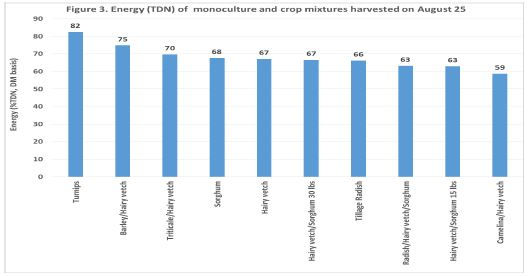Highlights of On-Farm Test Plots of Some Annuals for Cover Crop Cocktail Mixtures
- PCBFA

- Oct 9, 2019
- 3 min read
Research Coordinator: Dr. Akim Omokanye
Collaborating producer: Curt and Patty Hale (Clear Hills County)
From: Peace Country Beef & Forage Association 2014 Annual Report
Recent environmental and ecological awareness, and the willingness of producers (with verse knowledge on cover cropping) to share their experiences with other producers has started a resurgence in cover crop use in beef cattle operations. A series of workshops on cover cropping put on by PCBFA has shown that the advantages of integrating cover cropping systems into the forage based production systems of beef cattle operations are numerous. Cover crops protect water quality by reducing losses of nutrients, pesticides, and sediment. Cover crops can increase nutrient efficiency through reduced soil erosion (less soil organic matter and soil nutrients losses in the topsoil). Cover crops are scavengers of residual nitrogen (N), converting N to proteins (enzymes, hormones, amino acids). Improved forage yield and quality are some of the other benefits of cover cropping. This report attempts to highlight the collaborating producer’s efforts on testing a series of cover crop species that can be used in cover crop cocktail mixtures for silage for backgrounding or for swath grazing.
Methods
Cover crop test plots consisting of several monocultures and cocktail mixtures were seeded by the collaborating producer. The crops used for the test plots are listed below (Table 1).

These crops were seeded as monocultures in one section and in various mixtures in another section (where cross seeding was carried out). In this report, only 10 of the monocultures/cocktail mixtures are examined for forage and quality. The 10 monocultures/cocktail mixtures and their seeding rates are:

1. Turnips 1 lb
2. Barley 100 lbs/Hairy vetch 10 lbs
3. Triticale 100lbs/Hairy vetch 10 lbs
4. Sorghum 15 lbs
5. Hairy vetch 10 lbs
6. Hairy vetch 10 lbs/Sorghum 30 lbs
7. Tillage Radish 8 lbs
8. Radish 8 lbs/Hairy vetch 10lbs/Sorghum 15 lbs
9. Hairy vetch 10lbs/Sorghum-15lbs
10. Camelina 4 lbs/Hairy vetch 10 lbs
The plots were harvested for forage DM yield estimation on August 15. Dried forage samples were analyzed for forage quality by Central Testing Laboratory, Winnipeg, Manitoba.
Results
Forage Dry Matter (DM) Yield
A mixture of triticale/hairy vetch had the most forage DM yield (3703 lbs/ac), followed by monoculture purple top turnips (whole plant, 3200 lbs/ac) and then a mixture of barley/hairy vetch (2777 lbs/acre) (Figure 1). Monoculture sorghum sudan grass had the least DM (2159 lbs/ac).
Forage Quality
Protein - The forage protein was highest for barley/hairy vetch mixture (19%) and least for triticale/hairy vetch mixture (9%) (Figure 2). All monocultures and mixtures examined in the present study were able to meet the protein requirements of a dry gestating cow, which needs 7 and 9% respectively in mid and late pregnancy. For a nursing (lactating) cow that needs 11% protein, only monoculture sorghum sudan grass and a mixture of triticale/hairy vetch fell short of meeting the requirement of 11% by this category of cow. For growing and finishing calves, which require 12-13% protein, only monoculture sorghum sudan grass and a mixture of triticale/hairy vetch fell short of meeting the 12-13% protein needed by these calves.


Energy - The forage energy (total digestible nutrients, TDN) was generally >60% TDN (except for the mixture of camelina/hairy vetch) (Figure 3). All monocultures and mixtures tested here had enough %TDN for a dry gestating cow, but only the bottom 3 mixtures (in Figure 3) fell short of meeting the 65% TDN needed by a lactating cow (see Figure 3). Growing and finishing calves require 65-70% TDN, and looking at Figure 3, only the bottom 3 mixtures fell short of meeting the % TDN requirements of these calves.
Looking at the ME values in the present study (Table 2), only the mixture of Camelina/Hairy vetch fell short of meeting the daily ME requirements of 2.23 to 2.54 mcal/kg of a mature beef cow.

Macro minerals - The forage Ca, Mg and K contents were highest for purple top turnips. Tillage radish appeared to have the most forage P (0.29% P) and Na (0.34% Na) (Table 2). All monocultures and mixtures had adequate Ca and K for a dry gestating cow. For a lactating cow, only the mixture of triticale/hairy vetch fell short of meeting the Ca requirement of this category of cow. All monocultures and mixtures (except for sorghum sudan grass) had adequate P needed by a dry gestating cow. Only the mixture of triticale/hairy vetch did not have sufficient Mg for a dry gestating cow. Only monoculture turnips, monoculture tillage radish and a mixture of tillage radish/hairy vetch/sorghum had adequate Na needed by a dry gestating cow.






Comments